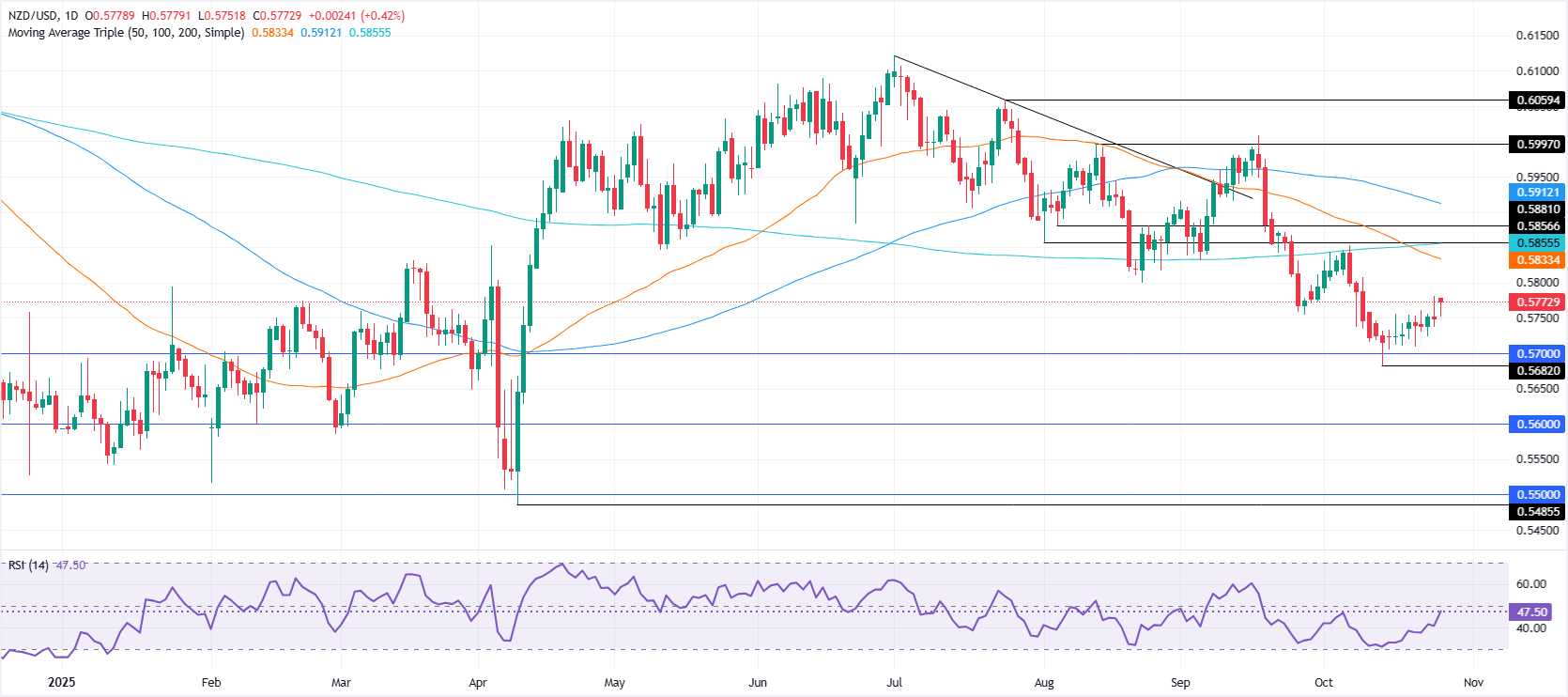- NZD/USD trades near 0.5771, pressured by dovish expectations for the Reserve Bank of New Zealand.
- Pair holds slightly above the 20-day SMA (0.5762), but bearish RSI hints at downside momentum.
- A drop below 0.5700 exposes the October 14 low at 0.5682, while resistance aligns at 0.5830–0.5857.
The NZD/USD opens the week with losses of over 0.14% on Monday, trading at around 0.5771 after opening the session at around 0.5778 as risk appetite improved. Despite this, the Kiwi failed to rally on expectations that the Reserve Bank of New Zealand might cut rates at the November 26 meeting.
NZD/USD Price Forecast: Technical outlook
The NZD/USD is downward biased, despite recovering some ground and climbing above the 20-day Simple Moving Average (SMA) at 0.5762. The Relative Strength Index (RSI) is bearish, confirming that the downtrend could resume. In the near term.
If NZD/USD dives below the 20-day SMA, the next support would be 0.5700. A breach of the latter will expose the October 14 swing low of 0.5682, followed by 0.5600.
Conversely, if NZD/USD rises past 0.5800, buyers could remain hopeful of testing higher key resistance levels. the first one would be the 50-day SMA at 0.5830, followed by the 200-day SMA at 0.5857, ahead of the 100-day SMA at 0.5909.
NZD/USD Price Chart – Daily

New Zealand Dollar FAQs
The New Zealand Dollar (NZD), also known as the Kiwi, is a well-known traded currency among investors. Its value is broadly determined by the health of the New Zealand economy and the country’s central bank policy. Still, there are some unique particularities that also can make NZD move. The performance of the Chinese economy tends to move the Kiwi because China is New Zealand’s biggest trading partner. Bad news for the Chinese economy likely means less New Zealand exports to the country, hitting the economy and thus its currency. Another factor moving NZD is dairy prices as the dairy industry is New Zealand’s main export. High dairy prices boost export income, contributing positively to the economy and thus to the NZD.
The Reserve Bank of New Zealand (RBNZ) aims to achieve and maintain an inflation rate between 1% and 3% over the medium term, with a focus to keep it near the 2% mid-point. To this end, the bank sets an appropriate level of interest rates. When inflation is too high, the RBNZ will increase interest rates to cool the economy, but the move will also make bond yields higher, increasing investors’ appeal to invest in the country and thus boosting NZD. On the contrary, lower interest rates tend to weaken NZD. The so-called rate differential, or how rates in New Zealand are or are expected to be compared to the ones set by the US Federal Reserve, can also play a key role in moving the NZD/USD pair.
Macroeconomic data releases in New Zealand are key to assess the state of the economy and can impact the New Zealand Dollar’s (NZD) valuation. A strong economy, based on high economic growth, low unemployment and high confidence is good for NZD. High economic growth attracts foreign investment and may encourage the Reserve Bank of New Zealand to increase interest rates, if this economic strength comes together with elevated inflation. Conversely, if economic data is weak, NZD is likely to depreciate.
The New Zealand Dollar (NZD) tends to strengthen during risk-on periods, or when investors perceive that broader market risks are low and are optimistic about growth. This tends to lead to a more favorable outlook for commodities and so-called ‘commodity currencies’ such as the Kiwi. Conversely, NZD tends to weaken at times of market turbulence or economic uncertainty as investors tend to sell higher-risk assets and flee to the more-stable safe havens.